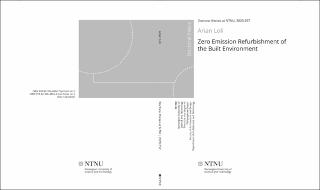| dc.contributor.author | Loli, Arian | |
| dc.date.accessioned | 2020-09-02T07:55:12Z | |
| dc.date.available | 2020-09-02T07:55:12Z | |
| dc.date.issued | 2020 | |
| dc.identifier.isbn | 978-82-326-4863-4 | |
| dc.identifier.issn | 1503-8181 | |
| dc.identifier.uri | https://hdl.handle.net/11250/2675936 | |
| dc.description.abstract | Nowadays, measures that aim minimum environmental impact are conceived for recent buildings. Greenhouse gas (GHG) emissions are reduced and balanced from renewable energy sources in a lifecycle perspective, while energy saving is achieved with cost-effective actions that secure comfort benefits. However, maintenance and adaptation interventions in historic buildings do not have the same objectives as in modern buildings. Additional requirements have to be followed, such as the use of materials compatible with the original and the preservation of authenticity to ensure historic, social, cultural and artistic values over time.
The presented work aims to overcome the collaboration difficulties among different communities associated with heritage conservation through the definition of a framework that includes all the necessary steps from study to practice in a methodologic way. The Zero Emission Refurbishment (ZER) method considers conservative requirements and environmental impact for the selection of the most sustainable intervention measures. It recategorizes the protection status of the buildings with the decay level of the materials to find suitable low-carbon interventions that satisfy the requests of the involved stakeholders. The results, given at a district scale, enable the intervention works to be implemented through large-scale projects, thus ensuring their uniformity and reduction of time and cost of the actions.
The ZER method is flexible and comprehensive, and it can be applied to diverse built environments. It can be further improved through practice and research, maintaining the principle of independence of the involved communities where the output of each community serves as the input for the other. Future work has to be motivated towards unifying the categorisation systems regardless the location, increasing the accuracy of the decay assessment for the components and pointing areas of the buildings which can serve for the production and storage of the necessary energy to reach ZER balance.
The application of the method in a block of buildings in the city of Trondheim showed the reduction potential of emissions before undergoing large-scale interventions. The overall carbon footprint of the intervention measures, linked with the energy improvement of the buildings after the completion of the works, serves as an indicator for the estimation of renewable energy generated from the neighbourhood and therefore, for the shift towards Zero Emission Neighbourhoods in historic urban cities. Working with heritage buildings adds complexity to the standard interventions; however, a sustainable approach for reducing greenhouse gas emissions while at the same time ensuring the best possible preservation strategies is a challenge that needs to be faced for the present and future generations. | en_US |
| dc.language.iso | eng | en_US |
| dc.publisher | NTNU | en_US |
| dc.relation.ispartofseries | Doctoral theses at NTNU;2020:257 | |
| dc.relation.haspart | Paper 1:
Loli, Arian; Bertolin, Chiara.
Towards Zero-Emission Refurbishment of Historic Buildings: A Literature Review. Buildings 2018 ;Volum 8.(2) s. 22-38
https://doi.org/10.3390/buildings8020022
This is an open access article distributed under the Creative Commons Attribution License (CC BY 4.0) | |
| dc.relation.haspart | Paper 2:
Bertolin, Chiara; Loli, Arian.
Sustainable interventions in historic buildings: A developing decision making tool. Journal of Cultural Heritage 2018 ;Volum 34. s. 291-302
https://doi.org/10.1016/j.culher.2018.08.010 | |
| dc.relation.haspart | Paper 3:
Loli, Arian; Bertolin, Chiara.
Indoor Multi-Risk Scenarios of Climate Change Effects on Building Materials in Scandinavian Countries. Geosciences 2018 ;Volum 8.(9) s. 347-365
https://doi.org/10.3390/geosciences8090347
This is an open access article Content from this work may be used under the terms of the Creative Commons Attribution 3.0 licence | |
| dc.relation.haspart | Paper 4:
Loli, Arian; Bertolin, Chiara; Kotova, Lola.
Service life prediction of building components in the times of climate change.
IOP Conference Series: Materials Science and Engineering. | |
| dc.relation.haspart | Paper 5:
Loli, Arian; Bertolin, Chiara; Kleiven, Tommy.
Refurbishment of historic buildings at a district scale: Enhancement of cultural value and emission reduction potential. IOP Conference Series: Earth and Environmental Science (EES) 2019 ;Volum 352.(1) s. 1-11
https://doi.org/10.1088/1755-1315/352/1/012023
- Content from this work may be used under the terms of the Creative Commons Attribution 3.0 licence CC-BY | |
| dc.relation.haspart | Paper 6:
Loli, Arian; Bertolin, Chiara.
Application of Zero Emission Refurbishment method at a district scale
Proceedings of the 2nd
International Conference on Urban Risks (ICUR2020) | |
| dc.title | Zero Emission Refurbishment of the Built Environment | en_US |
| dc.type | Doctoral thesis | en_US |
| dc.subject.nsi | VDP::Humanities: 000::Architecture and design: 140 | en_US |
